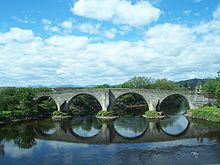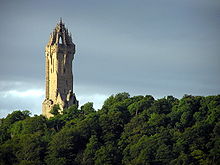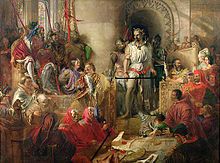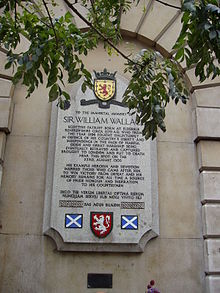- William Wallace
-
Sir William Wallace 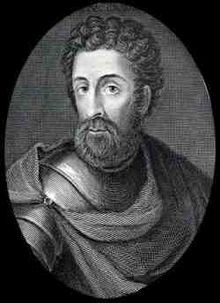
Born unknown date
Elderslie, Renfrewshire, ScotlandDied 23 August 1305
Smithfield, London, EnglandCause of death Hanged, drawn and quartered Occupation Commander in the Scottish Wars of Independence Children None recorded Parents Alan or Malcolm Wallace (father) Sir William Wallace (Medieval Gaelic: Uilliam Uallas; modern Scottish Gaelic: Uilleam Uallas; died 23 August 1305) was a Scottish knight and landowner who became one of the main leaders during the Wars of Scottish Independence.[1]
Along with Andrew Moray, Wallace defeated an English army at the Battle of Stirling Bridge in 1297, and was Guardian of Scotland, serving until his defeat at the Battle of Falkirk. In 1305, Wallace was captured in Robroyston near Glasgow and handed over to King Edward I of England, who had him hanged, drawn, and quartered for high treason and crimes against English civilians.
Since his death, Wallace has obtained an iconic status far beyond his homeland. He is the protagonist of the 15th century epic poem The Acts and Deeds of Sir William Wallace, Knight of Elderslie, by Blind Harry. Wallace is also the subject of literary works by Sir Walter Scott and Jane Porter and the Academy Award winning epic film, Braveheart.
Contents
Background
Although he was a minor member of the Scottish nobility, little is known for certain of William Wallace's family history. The early members of the family are recorded as holding estates at Riccarton, Tarbolton, and Auchincruive in Kyle, and Stenton in Haddingtonshire.[2] They were vassals of James Stewart, 5th High Steward of Scotland as their lands fell within his territory.
Some sources give his father's name as Malcolm Wallace, but the seal attached to a letter sent to the Hanse city of Lübeck in 1297[3] appears to give his father's name as Alan.[4][5] His brothers Malcolm and John are known from other sources.[6] An Alan Wallace appears in the Ragman Rolls as a crown tenant in Ayrshire, but there is no additional confirmation.[7] The traditional view is that Wallace's birthplace was Elderslie in Renfrewshire, and this is still the view of most historians,[8] but there have been recent claims that it was Ellerslie in Ayrshire. There is no contemporary evidence linking him with either location, although both areas were linked to the wider Wallace family.[9]
His year of birth can only be guessed at, although he was probably a relatively young man at the time of his military exploits and death. It is not known if he was ever married, or if he had any children.
Political crisis in Scotland
When Wallace was growing up, King Alexander III[10] ruled Scotland. His reign had seen a period of peace and economic stability. In 1286, however, Alexander died after falling from his horse.
The heir to the throne was Alexander's granddaughter, Margaret, Maid of Norway. As she was still a child and in Norway, the Scottish lords set up a government of guardians. Margaret died on the voyage to Scotland. The lack of a clear heir led to a period known as the 'Great Cause', with several families laying claim to the throne.
With Scotland threatening to descend into civil war, King Edward was invited in by the Scottish nobility to arbitrate. Before the process could begin, he insisted that all of the contenders recognise him as Lord Paramount of Scotland. In early November 1292, at a great feudal court held in the castle at Berwick-upon-Tweed, judgement was given in favour of John Balliol having the strongest claim in law.
Edward proceeded to reverse the rulings of the Scottish Lords and even summoned King John Balliol to stand before the English court as a common plaintiff. John was a weak king, known as "Toom Tabard", or "Empty Coat". John renounced his homage in March 1296 and by the end of the month Edward stormed Berwick-upon-Tweed, sacking the then-Scottish border town. In April, the Scots were defeated at the Battle of Dunbar in East Lothian and by July Edward had forced John to abdicate. Edward then instructed his officers to receive formal homage from some 1,800 Scottish nobles (many of the rest being prisoners of war at that time).
Military career
The start of the uprising
Wallace enters history when he assassinated William de Heselrig, the English High Sheriff of Lanark, in May 1297. He then joined with William the Hardy, Lord of Douglas, and they carried out the raid of Scone. This was one of several rebellions taking place across Scotland, including several Scottish nobles and Andrew Moray in the north.[8]
The uprising suffered a blow when the nobles submitted to the English at Irvine in July. Wallace and Moray were not involved, and continued their rebellions. Wallace used Selkirk Forest as a base for raiding, and attacked Wishart's palace at Ancrum. Wallace and Moray met and joined their forces, possibly at the siege of Dundee in early September.[8]
Battle of Stirling Bridge
On September 11, 1297, an army jointly led by Wallace and Andrew Moray won the Battle of Stirling Bridge. Although vastly outnumbered, the Scottish army routed the English army. John de Warenne, 6th Earl of Surrey's professional army of 3,000 cavalry and 8,000 to 10,000 infantry met disaster as they crossed over to the north side of the river. The narrowness of the bridge prevented many soldiers from crossing together (possibly as few as three men abreast), so while the English soldiers crossed, the Scots held back until half of them had passed and then killed the English as quickly as they could cross. The infantry were sent on first, followed by heavy cavalry. But the Scots' sheltron formations forced the infantry back into the advancing cavalry. A pivotal charge, led by one of Wallace's captains, caused some of the English soldiers to retreat as others pushed forward, and under the overwhelming weight, the bridge collapsed and many English soldiers drowned. The Scots won a significant victory which boosted the confidence of their army. Hugh Cressingham, Edward's treasurer in Scotland, died in the fighting and it is reputed that his body was subsequently flayed and the skin cut into small pieces as tokens of the victory. The Lanercost Chronicle records that Wallace had "a broad strip [of Cressingham’s skin] ... taken from the head to the heel, to make therewith a baldrick for his sword".[11]
After the battle, Moray and Wallace assumed the title of Guardians of the kingdom of Scotland on behalf of King John Balliol. Moray died of wounds suffered on the battlefield sometime in late 1297.
The type of engagement used by Wallace was contrary to the contemporary views on chivalric warfare whereby strength of arms and knightly combat was espoused in the stead of tactical engagements and strategic use of terrain. The battle thus embittered relations between the two antagonistic nations, whilst also perhaps providing a new departure in the type of warfare with which England had hitherto engaged. The numerical and material inferiority of the Scottish forces would be mirrored by the English in the Hundred Years' War, who, in turn, abandoned chivalric warfare to achieve decisive victory in similar engagements such as Crécy and Poitiers.
Around November 1297, Wallace led a large-scale raid into northern England, through Northumberland and Cumberland.[8]
Around then Wallace was knighted. This would have been carried out by one of three Scottish earls: Carrick, Strathearn or Lennox.[8][12][13]
Battle of Falkirk
In 1298, Wallace lost the Battle of Falkirk. On 1 April 1298, the English invaded Scotland at Edinburgh. They plundered Lothian and regained some castles, but had failed to bring Wallace to combat. The Scots adopted a scorched earth policy and hit and run tactics. The English quartermasters' failure to prepare for the expedition left morale and food low, but Edward's search for Wallace would not end at Falkirk.
Wallace arranged his spearmen in four schiltrons — circular, hedgehog formations surrounded by a defensive wall of wooden stakes. The English however employed Welsh longbowmen which swung strategic superiority in their favour. The English proceeded to attack with cavalry, and break up the Scottish archers. Under the command of the Scottish nobles, the Scottish knights withdrew, and Edward's men began to attack the schiltrons. It remains unclear whether the infantry shooting bolts, arrows and stones at the spearmen proved the deciding factor, although it is very likely that it was the arrows of Edward's bowmen. Gaps in the schiltrons soon appeared, and the English exploited these to crush the remaining resistance. The Scots lost many men, including John de Graham. Wallace escaped, though his military reputation suffered badly.
By September 1298, Wallace had decided to resign as Guardian of Scotland in favour of Robert the Bruce, Earl of Carrick and future king, and John Comyn of Badenoch, King John Balliol's nephew.
Details of Wallace's activities after this are vague, but there is some evidence that he left on a mission to the court of King Philip IV of France to plead the case for assistance in the Scottish struggle for independence. There is a surviving letter from the French king dated 7 November 1300 to his envoys in Rome demanding that they should help Sir William.[14] There is also a report from an English spy at a meeting of Scottish leaders, where they said Wallace was in France.
In 1304 he was back in Scotland, and involved in skirmishes at Happrew and Earnside.
Capture and execution
Wallace evaded capture by the English until 5 August 1305 when John de Menteith, a Scottish knight loyal to Edward, turned Wallace over to English soldiers at Robroyston near Glasgow. Wallace was transported to London and taken to Westminster Hall, where he was tried for treason and for atrocities against civilians in war, "sparing neither age nor sex, monk nor nun.".[15][16] He was crowned with a garland of oak to suggest he was the king of outlaws. He responded to the treason charge, "I could not be a traitor to Edward, for I was never his subject." With this, Wallace asserted that the absent John Balliol was officially his king.[citation needed]
Following the trial, on 23 August 1305, Wallace was taken from the hall, stripped naked and dragged through the city at the heels of a horse to the Elms at Smithfield. He was hanged, drawn and quartered — strangled by hanging but released while he was still alive, castrated, eviscerated and his bowels burnt before him, beheaded, then cut into four parts. His preserved head (dipped in tar) was placed on a pike atop London Bridge.[17] It was later joined by the heads of the brothers, John and Simon Fraser. His limbs were displayed, separately, in Newcastle upon Tyne, Berwick-upon-Tweed, Stirling, and Aberdeen. A plaque stands in a wall of St. Bartholomew's Hospital near the site of Wallace's execution at Smithfield.
In 1869 the Wallace Monument was erected, very close to the site of his victory at Stirling Bridge. The Wallace Sword, which supposedly belonged to Wallace, although some parts are at least 160 years later in origin, was held for many years in Dumbarton Castle and is now in the Wallace Monument.
Historiography of Wallace
Although there are problems with writing a satisfactory biography of many medieval people, the problems with Wallace are greater than normal. Not much is known about him beyond his military campaign of 1297-98, and the last few weeks of his life in 1305. Even in recent years, there has been some dispute about his birthplace and his father's name.
To compound this, the legacy of subsequent 'biographical' accounts, sometimes written as propaganda, other times simply as entertainment, has clouded much scholarship until relatively recently. Some accounts have uncritically copied elements from the epic poem, The Acts and Deeds of Sir William Wallace, Knight of Elderslie, written around 1470 by Blind Harry the minstrel. Harry wrote from oral tradition describing events 170 years earlier, and is not in any sense an authoritative description of Wallace's exploits. Much of it is clearly at variance with known historical facts and records of the period and is either fabricated using traditional chivalric motifs or 'borrowed' from the exploits of others and attributed to Wallace.
Wallace in fiction
In the early 19th century, Walter Scott wrote of Wallace in Exploits and Death of William Wallace, the "Hero of Scotland", and Jane Porter penned a romantic version of the Wallace legend in The Scottish Chiefs in 1810. G. A. Henty wrote a novel in 1885 about this time period titled In Freedom's Cause. Henty, a producer of Boy's Own Paper fiction who wrote for that magazine, portrays the life of William Wallace, Robert the Bruce, The Black Douglas, and others, while dovetailing the novel with historical fiction. Nigel Tranter wrote a historical novel titled The Wallace, published in 1975, which is said to be more accurate than its literary predecessors. In 2010, the novelist Jack Whyte gave another fictionalized account of Wallace’s life, particularly his early life, in The Forest Laird, the first book in The Guardians of Scotland trilogy.
A well-known account is presented in the film Braveheart, directed by and starring Mel Gibson, written by Randall Wallace, and filmed in both Scotland and Ireland. The film, a highly fictionalized account of Wallace's life, was a commercial success and won five Academy Awards, including Best Picture and Best Director.
William Wallace is also the subject of the Tutorial campaign in the popular video game Age of Empires II: Age of Kings.
Sources
- Barrow, G. W. S. (1989), Kingship and Unity: Scotland 1000–1306, The New History of Scotland, 2 (2nd ed.), Edinburgh: Edinburgh University Press, ISBN 0-7486-0104-X
- Barrow, G. W. S. (1976), Robert Bruce and the Community of the Realm of Scotland (2nd ed.), Edinburgh: Edinburgh University Press, ISBN 0-85224-307-3
- Barrow, G. W. S. (2003), The Kingdom of the Scots: Government, Church and Society from the eleventh to the fourteenth century (2nd ed.), Edinburgh: Edinburgh University Press, ISBN 0-7486-1803-1
- Brown, Michael (2004), The Wars of Scotland 1214–1371, The New Edinburgh History of Scotland, 4, Edinburgh: Edinburgh University Press, ISBN 0-7486-1238-6
- Cowan, Edward J. (2003), 'For Freedom Alone': The Declaration of Arbroath, 1320, West Linton: Tuckwell Press, ISBN 1-84158-632-3
- Cowan, Edward J.; Finlay, Richard J., eds. (2002), Scottish History: The Power of the Past, Edinburgh: Edinburgh University Press, ISBN 0-7486-1420-6
- Cowan, Edward J., ed. (2007), The Wallace Book, Edinburgh: John Donald, ISBN 9780-85976-652-4
- Cowan, Edward J. (2007), "William Wallace: 'The Choice of the Estates'", in Cowan, Edward J., The Wallace Book, Edinburgh: John Donald, pp. 9–25, ISBN 9780-85976-652-4
- Duncan, A. A. M. (2007), "William, Son of Alan Wallace: The Documents", in Cowan, Edward J., The Wallace Book, Edinburgh: John Donald, pp. 42–63, ISBN 9780-85976-652-4
- Fisher, Andrew (2002), William Wallace (2nd ed.), Edinburgh: Birlinn, ISBN 1-84158-593-9
- Fraser, James E. (2002), "'A Swan from a Raven': William Wallace, Brucean Propaganda and Gesta Annalia II", The Scottish Historical Review (Edinburgh: Edinburgh University Press) LXXXI (1): 1–22, ISSN 0036-9241
- Grant, Alexander (2007), "Bravehearts and Coronets: Images of William Wallace and the Scottish Nobility", in Cowan, Edward J., The Wallace Book, Edinburgh: John Donald, pp. 86–106, ISBN 9780-85976-652-4
- King, Elspeth (2007), "The Material Culture of William Wallace", in Cowan, Edward J., The Wallace Book, Edinburgh: John Donald, pp. 117–135, ISBN 9780-85976-652-4
- Prestwich, Michael (2007), "The Battle of Stirling Bridge: An English Perspective", in Cowan, Edward J., The Wallace Book, Edinburgh: John Donald, pp. 64–76, ISBN 9780-85976-652-4
- Riddy, Felicity (2007), "Unmapping the Territory: Blind Hary's Wallace", in Cowan, Edward J., The Wallace Book, Edinburgh: John Donald, pp. 107–116, ISBN 9780-85976-652-4
- Watson, Fiona (2002), "The Demonisation of King John", in Cowan, Edward J.; Finlay, Richard J., Scottish History: The Power of the Past, Edinburgh: Edinburgh University Press, pp. 29–46, ISBN 0-7486-1420-6
- Watson, Fiona (2007), "Sir William Wallace: What We Do — and Don't — Know", in Cowan, Edward J., The Wallace Book, Edinburgh: John Donald, pp. 26–41, ISBN 9780-85976-652-4
- Young, Alan (1997), Robert the Bruce's Rivals: The Comyns, 1212–1314, East Linton: Tuckwell Press, ISBN 1-86232-053-5
- Brown, Chris. William Wallace. The True Story of Braveheart. Stroud: Tempus Publishing Ltd, 2005. ISBN 0-7524-3432-2.
- The Chronicle of Lanercost 1272–1346, ed. H. Maxwell, 1913;
- Clater-Roszak, Christine. "Sir William Wallace ignited a flame." Military History 14 (1997): 12–15.
- Harris, Nathaniel. Heritage of Scotland: A Cultural History of Scotland & Its People. London: Hamlyn, 2000. ISBN 0-600-59834-9.
- Loudoun, Darren John. Scotland's Brave. Sydney: Paragon Books, 2007.
- MacLean, Fitzroy. Scotland: A Concise History. London: Thames & Hudson, 1997. ISBN 0-500-27706-0.
- Morton, Graeme. William Wallace. London: Sutton, 2004. ISBN 0-7509-3523-5.
- Reese, Peter. William Wallace: A Biography. Edinburgh: Canongate, 1998. ISBN 0-86241-607-8.
- Scott, Sir Walter. Exploits and death of William Wallace, the 'Hero of Scotland'
- Stead, Michael J., and Alan Young. In the Footsteps of William Wallace. London: Sutton, 2002.
- Folklore, Myths and Legends of Britain. London: Reader’s Digest Association, 1973, 519–20.
- Whyte, Jack (2010), The Forest Laird, Toronto, Ontario: Penguin Group, ISBN 978-0-670-06846-3
- Traquair, Peter (1998), Freedom's Sword, Hammersmith, London: Harper Collins, ISBN 00034720792
See also
- Auchenbathie Tower - Wallace's Knowe
- Clan Wallace
- Owain Glyndŵr
Notes
- ^ "William Wallace (c. 1270–1305)". Bbc.co.uk. http://www.bbc.co.uk/history/historic_figures/wallace_william.shtml. Retrieved 2010-04-04.
- ^ Barrow, Kingdom of the Scots, pp. 324–325.
- ^ Lübecker Nachrichten, 21. September 2010: The document is still kept in the cities archives
- ^ Duncan, "William, son of Alan Wallace", pp. 47–50; Grant, "Bravehearts and Coronets", p. 91.
- ^ The Scottish Wars of Independence: The Lübeck Letter at the National Archives of Scotland website
- ^ Duncan, "William, son of Alan Wallace", p. 53; Grant, "Bravehearts and Coronets", pp. 91–92.
- ^ Watson, "Sir William Wallace", p. 27; Duncan, "William, son of Alan Wallace", pp. 51–53; Grant, "Bravehearts and Coronets", pp. 90–93.
- ^ a b c d e Traquiar Freedom's Sword
- ^ Watson, "Sir William Wallace", p. 27; Grant, "Bravehearts and Coronets", pp. 90–91.
- ^ (Medieval Gaelic: Alaxandair mac Alaxandair; Modern Gaelic: Alasdair mac Alasdair)
- ^ Chronicle of Lanercost, ed. H. Maxwell, vol.1, p.164.
- ^ "Scottish Historical Figures: Sir William Wallace". Scotsmart.com. http://www.scotsmart.com/info/histfigures/wallace.html. Retrieved 2010-04-04.
- ^ John Prebble The Lion in the North
- ^ Watson, The Wallace Book, p36
- ^ Solis, Gary (2010). The law of armed conflict: international humanitarian law in war. Cambridge University Press. p. 6. ISBN 978-0521870887.
- ^ Goldstone, Richard; Smith, Adam (2009). International Judicial Institutions (Global Institutions). Routledge. p. 31. ISBN 978-0415776455.
- ^ "The Trial Of William Wallace". Angelfire.com. http://www.angelfire.com/nh/Scotland/wmwallace.html. Retrieved 2010-04-04.
External links
 Quotations related to William Wallace at Wikiquote
Quotations related to William Wallace at Wikiquote- The Life of Sir William Wallace, by John D. Carryck (btm format)
- William Wallace and Battles of Stirling and Falkirk
- Wallace and Bruce
- The Lübeck letter
- Wallace letters to go on show
Categories:- William Wallace
- 1305 deaths
- 1305 in Scotland
- Guardians of Scotland
- People executed by hanging, drawing and quartering
- People executed for treason against England
- People of the Wars of Scottish Independence
- Prisoners in the Tower of London
- Scottish generals
- Scottish letter writers
- Scottish Roman Catholics
- Scottish rebels
Wikimedia Foundation. 2010.


